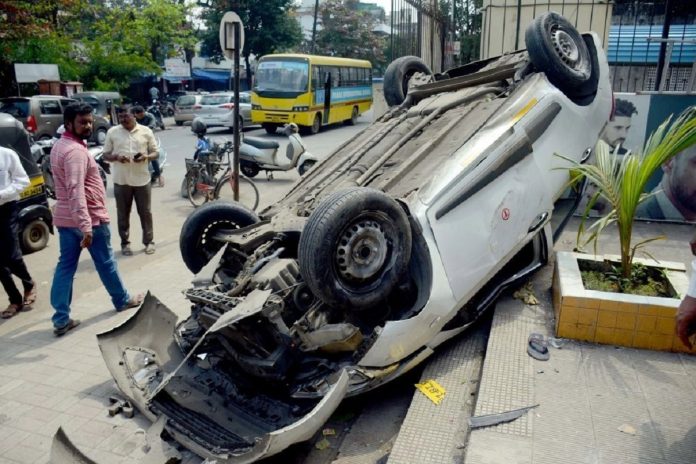A nationwide strike by truck drivers over increased penalties for hit-and-run cases winded down on Tuesday after the government promised to consult before enforcing the controversial provision in the new criminal code.
A significant number of around one crore truck drivers in the country went on strike, urging the government to retract a provision in the recently enacted Bharatiya Nyay Sanhita (BNS) that raises the imprisonment duration in hit-and-run cases from two to 10 years.
Setting aside the merit of the protest’s rationale, it is crucial to grasp why hit-and-run incidents elicit a range of public emotions, especially among individuals who have personally faced the adverse consequences of this menace.
The Data Speaks
In simple terms, hit-and-run accidents can be described as cases where an individual hits another vehicle while driving and flees from the scene.
As per the government’s annual ‘Road Accidents in India’ report, hit-and-run cases accounted for 14.6 per cent of all accidents and 18.1 per cent of all deaths in 2022. In 2021, these numbers were 13.9 per cent and 16.8 per cent.
In 2022, there were 67,387 incidents of hit and run that killed 30,486 people and injured 54,726 people.
Nevertheless, hit-and-run cases do not rank as the primary cause of road fatalities in India.
To be precise, among nine types of road accidents and associated deaths mentioned in the Road Ministry report, hit-and-run incidents held the fifth and second positions in 2022, with the top position being occupied by ‘Hit from Back’ cases.
Inconspicuous Culprit
The 2022 data challenges common beliefs, showing that, contrary to popular perception, trucks and lorries rank as the second leading cause of overall road accident fatalities.
Ironically, two wheelers are the leading agent, responsible for 47,171 accident deaths in 2022, and interestingly, they also top the list in the victim category.
A quick examination of the accident-victim matrix involving trucks reveals that two-wheelers are their biggest victims, followed by cars, LMVs, and other trucks and lorries.
Why A Menace
Hit-and-run incidents predominantly occur on highways or during the night where the accused do not get nabbed and there are often no eyewitnesses to validate events for the police. Additionally, reduced visibility of number plates during the night, coupled with the focus on the victim rather than the fleeing vehicle, diminishes the likelihood of capturing the offending vehicle.
While passers-by witnessing the crash refrain from reporting the matter to police due to legal hassles, the lack of surveillance cameras at the crash spot is another important reason for fleeing offenders.
Also, in some cases, drivers are propped up by owners of cars to own up responsibility on their behalf, which makes it difficult to ascertain who actually was behind the wheel.
To put this in perspective, the apathy of the general public and eyewitnesses to report the crashes means police have a harder time filing a charge sheet as they are unable to find the perpetrator.
The latest edition of the National Crime Records Bureau (NCRB) report reveals that charge sheets were filed in only 66.4 per cent of hit-and-run cases disposed of by police in 2022.
The Concern
Understanding the rationale behind the contentious provision is the first step in addressing the emotive issue of hit and run.
The growing incidents of hit and run, aided by the ‘absentee eyewitness’ call for law enforcers to stay ahead of the curve. This explains why the BNS clause has mandated a jail term of 10 years for those who leave the victim unattended to die on the road.
“Instances of hit and run cases are on the rise and it is necessary to convey that one cannot escape the law,” an official said, explaining the reason for including hit-and-run provisions in the proposed law.
“By bringing a law on hit-and-run cases or for that matter mob lynching, a framework has been created which addresses social concerns.”
However, while the new clause is equally applicable to two-wheeler, three-wheeler and cars, the three-day strike by truck, bus and tanker drivers raises many questions.
According to a report by ANI, private transport operators have claimed that the law discourages drivers and may lead to unjust punishments. They also claim that the drivers could be subject to mob violence when they attempt to transport the injured to hospitals and demand the repeal of the law, the report added.
Though the Centre has managed to douse the fire for the time being, numerous unanswered questions linger, leaving uncertainty about whether a beneficial rule for the general public will be upheld or revoked.
In 2022 alone, hit-and-run cases killed four people every hour. It is evident that the current penalty of a two-year jail term was not a substantial enough deterrent, as demonstrated by the alarming statistics.
Will 10 years do the trick? We don’t know. But the new clause is worth trying, and the Centre must consult all stakeholders before going ahead.


